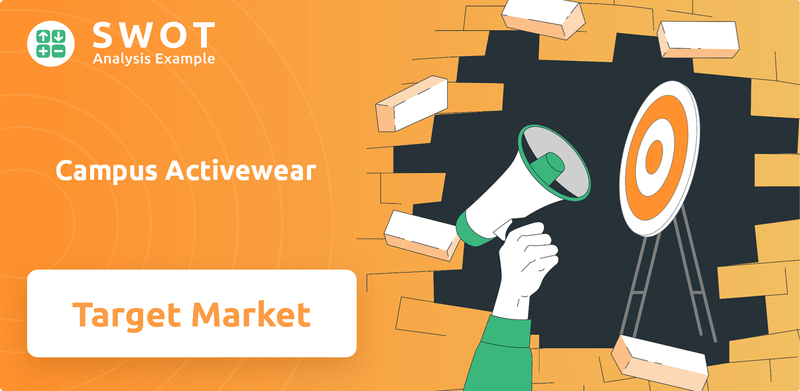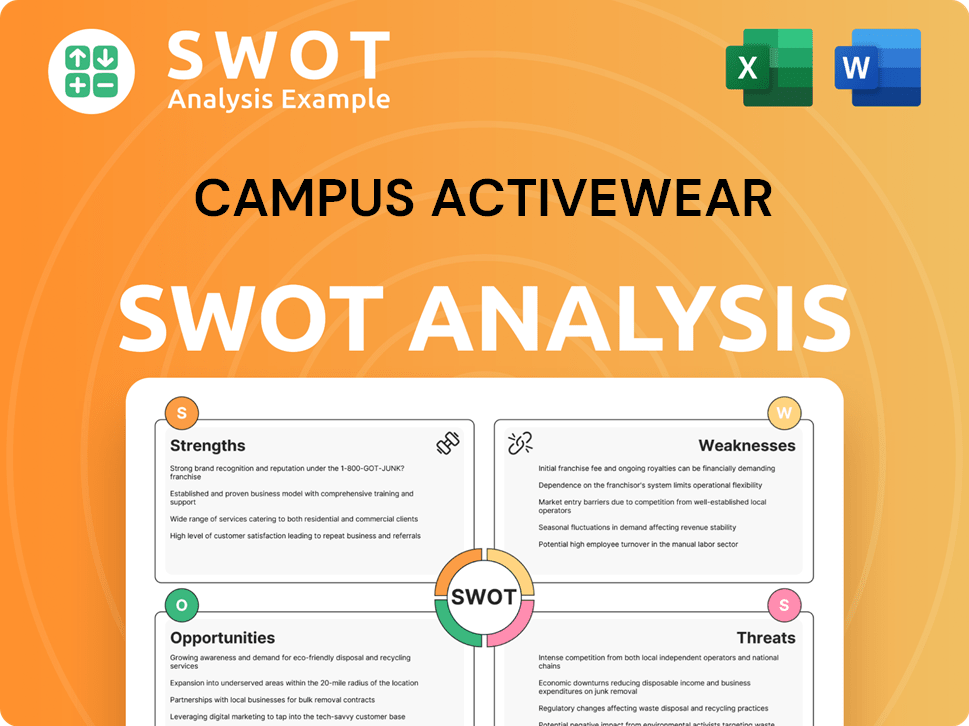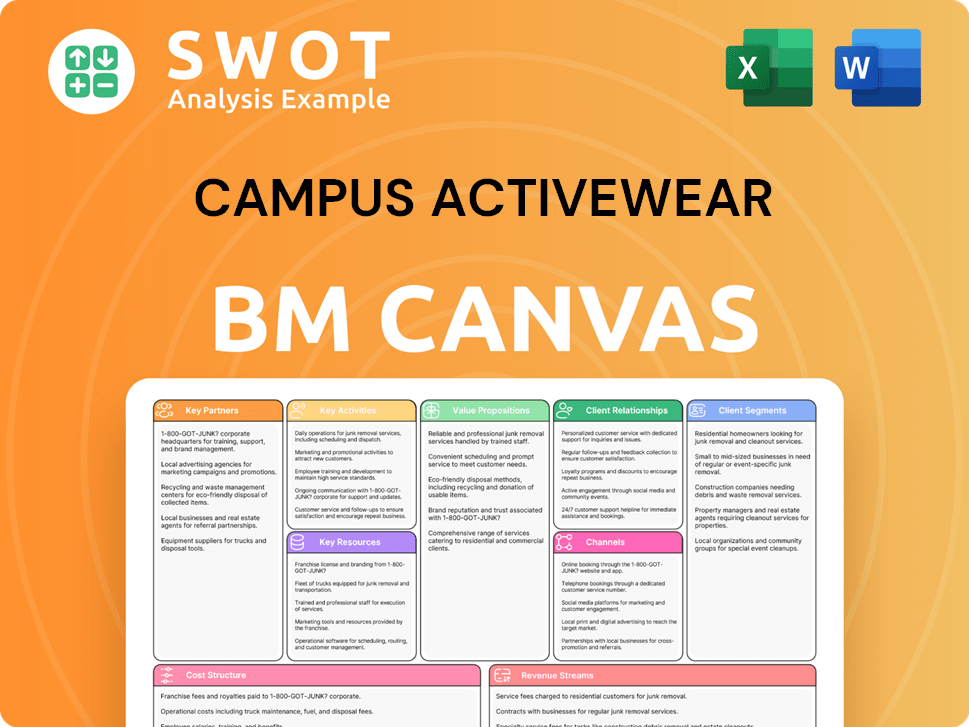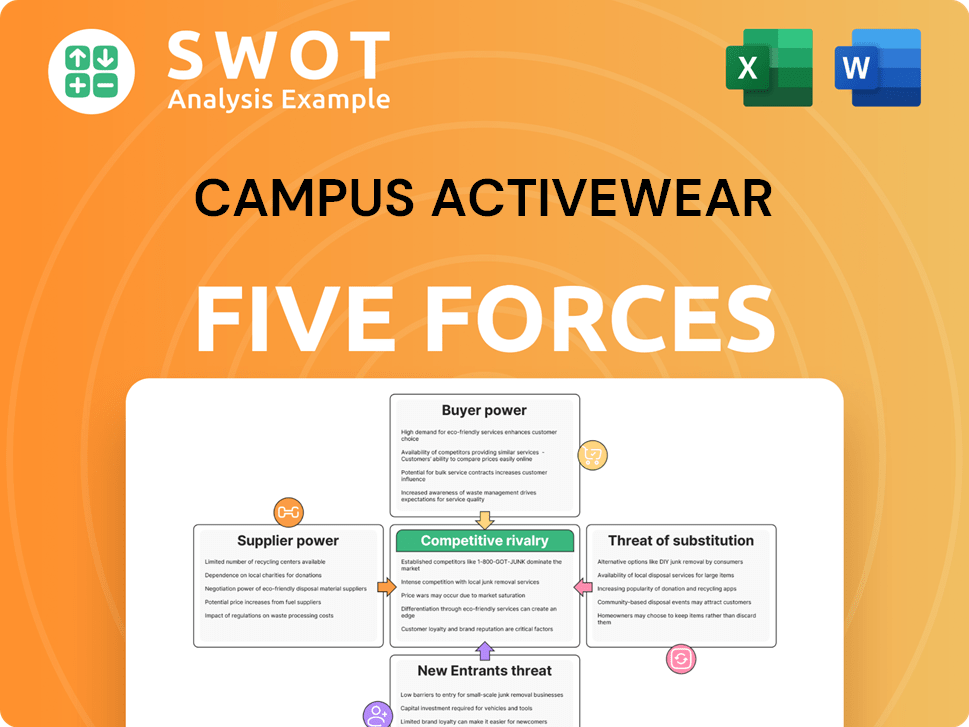Campus Activewear Bundle
Who Buys Campus Activewear Shoes?
Understanding the "Who" behind Campus Activewear’s success is crucial for investors and strategists alike. This deep dive into Campus Activewear SWOT Analysis will explore the company’s customer demographics and target market, revealing the core consumer profile driving its growth in the competitive footwear industry. We'll analyze the consumer buying behavior and market analysis to uncover the secrets behind Campus Activewear's strategic positioning.

From its humble beginnings in 2005, Campus Activewear has strategically navigated the Indian footwear market, evolving its approach to cater to specific lifestyle and athletic needs. This detailed examination will answer questions like "Who are the typical Campus Activewear customers?" and "What age group buys Campus Activewear shoes?" We'll also explore how Campus Activewear identifies its target market and its marketing strategies for demographics, offering actionable insights for anyone interested in the company's future trajectory and market share by customer segment.
Who Are Campus Activewear’s Main Customers?
Understanding the Growth Strategy of Campus Activewear involves a deep dive into its customer demographics and target market. The company primarily focuses on the Indian consumer market (B2C), with a broad age range, but heavily emphasizes youth and young adults. This strategic focus helps tailor products and marketing efforts effectively.
The core customer base of Campus Activewear is segmented by age, with a strong appeal to individuals aged between 15 and 45. This includes students, young professionals, and active adults. The company has expanded its women’s footwear collection, indicating a strategic move to capture a larger share of this growing segment. Income levels typically fall within the middle-income bracket, aligning with the company's value-for-money proposition.
The customer base's education and occupation vary, ranging from college students seeking trendy and comfortable footwear to working professionals looking for athletic or casual options. This diversity reflects the broad appeal of the brand across different lifestyles and needs.
Campus Activewear's customer demographics are primarily in the 15-45 age group, with a significant focus on youth. The company targets both genders, with a growing emphasis on women’s footwear. Income levels generally fall within the middle-income bracket, reflecting the brand's value-driven approach.
The target market is segmented by age, with the young adult segment (18-35 years) driving the largest share of revenue. This group is highly influenced by fashion trends and digital marketing. The company has broadened its appeal to include fashion-conscious consumers, moving beyond purely functional footwear.
The young adult segment is crucial for driving growth, influenced significantly by fashion and trends. The company's marketing campaigns, often featuring youth icons, reinforce its appeal to this demographic. In recent years, Campus Activewear has seen significant growth in online sales, reflecting changing consumer behavior and the increasing importance of digital channels.
- The young adult segment (18-35) is the primary driver of revenue and growth.
- Fashion trends and digital marketing significantly influence this segment.
- The company is expanding its product lines to cater to broader consumer preferences.
- Marketing strategies include collaborations and campaigns featuring youth icons.
Campus Activewear SWOT Analysis
- Complete SWOT Breakdown
- Fully Customizable
- Editable in Excel & Word
- Professional Formatting
- Investor-Ready Format

What Do Campus Activewear’s Customers Want?
Understanding the customer needs and preferences is crucial for the success of any business, and for the company, this involves a deep dive into what drives their customers' purchasing decisions. The company's customers are motivated by a mix of practical needs, psychological desires, and aspirational goals, shaping their choices in the footwear industry.
The primary needs revolve around comfort, durability, and affordability, which are essential for everyday wear and various activities. Psychologically, customers seek self-expression and a sense of belonging, with footwear often reflecting their personal style and active lifestyle. Aspirationally, the company's offerings allow customers to align with fitness trends and a modern image.
The company's approach addresses common customer pain points, such as the need for comfortable footwear for extended use and stylish options that don't compromise functionality. Customer feedback, gathered through online reviews and social media, is a key factor in product development, leading to improvements in design, materials, and comfort. For more insights, check out the Growth Strategy of Campus Activewear.
Customers prioritize comfort, durability, and affordability. They seek products that meet their daily needs and support their active lifestyles. These factors significantly influence the customer buying behavior analysis.
The decision-making process involves a balance between product features, brand reputation, and price. Customers evaluate these aspects to ensure they are making a worthwhile purchase. This is a key element in understanding the customer demographics.
Footwear usage varies, from daily casual wear to specific athletic activities. The versatility of the product line caters to a wide range of needs. This understanding helps in Campus Activewear target market segmentation.
Loyalty is influenced by consistent product quality, stylish designs, and effective customer service. These factors build trust and encourage repeat purchases. Understanding these elements is crucial for Campus Activewear's marketing strategies for demographics.
Customers are driven by the desire for self-expression and belonging. Footwear serves as a statement of personal style and an embodiment of an active lifestyle. This is a key aspect of the consumer profile.
The company's offerings allow customers to associate with fitness trends and a dynamic, modern image. This aspirational connection enhances brand appeal and customer engagement. This is important for the ideal customer profile for Campus Activewear.
The company directly addresses customer needs by focusing on comfort, style, and functionality. This includes using lightweight materials and breathable designs for athletic shoes, directly responding to customer preferences for enhanced comfort during physical activities. This is crucial for a detailed analysis of Campus Activewear's customer base.
- Comfort: Lightweight materials and ergonomic designs.
- Style: Trendy designs and vibrant color palettes.
- Functionality: Durable materials and supportive features.
- Feedback: Utilizing online reviews and social media to gather customer feedback.
Campus Activewear PESTLE Analysis
- Covers All 6 PESTLE Categories
- No Research Needed – Save Hours of Work
- Built by Experts, Trusted by Consultants
- Instant Download, Ready to Use
- 100% Editable, Fully Customizable

Where does Campus Activewear operate?
The geographical market presence of Campus Activewear is substantial and widespread across India. The company's distribution network covers a broad spectrum, including metropolitan areas, tier-2, and tier-3 cities. While specific market share data by city or region isn't publicly available, its reach suggests a strong presence in both urban and semi-urban centers. This strategic distribution enables it to tap into diverse consumer segments across the country, catering to varying preferences and income levels.
The company likely experiences its strongest market share and brand recognition in urban and semi-urban centers. These areas typically have higher consumer awareness, disposable income, and better access to both online and offline retail channels, which are key for the Owners & Shareholders of Campus Activewear. Differences in customer demographics and preferences are noticeable across regions. For example, consumers in metropolitan areas might prioritize fashion-forward designs and premium features, whereas those in smaller towns might value durability and affordability more.
To effectively compete in diverse markets, Campus Activewear tailors its offerings and marketing strategies. This includes adapting product assortments to regional preferences, using local dialects in advertising campaigns, and collaborating with regional influencers. The company's expansion into new markets is often guided by an analysis of regional economic growth, rising disposable incomes, and increasing health consciousness. The geographic distribution of sales and growth is likely skewed towards regions with a higher concentration of youth and middle-income households, aligning with its primary customer segments.
Campus Activewear has a wide distribution network across India, including metropolitan, tier-2, and tier-3 cities. Their strong presence in urban and semi-urban areas suggests a high degree of market penetration, especially considering the footwear industry's competitive landscape.
The company adapts its product offerings and marketing to suit regional tastes. This approach includes tailoring product assortments, using local languages in advertising, and collaborating with regional influencers. This localized strategy is crucial for attracting the diverse customer demographics.
Expansion into new markets is driven by factors like regional economic growth and rising disposable incomes. The company's consistent growth indicates a dynamic approach to market entry and consolidation. This strategic focus helps in reaching a wider target market.
The geographic distribution of sales is likely concentrated in regions with a high concentration of youth and middle-income households. This aligns with their primary customer segments, allowing for targeted marketing and product development. Understanding customer demographics is key.
Campus Activewear utilizes both online and offline retail channels to reach its target market. This omnichannel approach ensures accessibility for customers across different regions and income levels. This strategy enhances the consumer profile.
Campus Activewear conducts market analysis to understand regional economic trends and consumer behavior. This data-driven approach helps the company make informed decisions about product development, marketing strategies, and market expansion, crucial for understanding the target market.
Campus Activewear Business Model Canvas
- Complete 9-Block Business Model Canvas
- Effortlessly Communicate Your Business Strategy
- Investor-Ready BMC Format
- 100% Editable and Customizable
- Clear and Structured Layout

How Does Campus Activewear Win & Keep Customers?
Customer acquisition and retention are critical for the success of any company, and Campus Activewear is no exception. The company employs a multifaceted strategy to attract and keep customers, blending digital and traditional marketing approaches to reach a broad audience. This includes leveraging social media, search engine optimization (SEO), and collaborations with influencers to build brand awareness and drive sales.
The company focuses on building customer loyalty through various initiatives. These include loyalty programs, personalized experiences based on customer data, and excellent after-sales service. By understanding and catering to customer preferences, Campus Activewear aims to increase customer lifetime value and maintain a strong market position within the footwear industry. A strong understanding of the Revenue Streams & Business Model of Campus Activewear is key to understanding the company's customer acquisition and retention strategies.
Campus Activewear's strategies are designed to resonate with its target market, which includes a diverse range of consumers. By offering a mix of style, comfort, and affordability, the company aims to attract and retain customers across different demographics. The shift towards a more digitally-centric approach has enabled Campus Activewear to foster direct engagement and personalized communication with its customer base, leading to potentially increased customer loyalty.
Campus Activewear utilizes digital marketing extensively. This includes robust social media campaigns on platforms like Instagram and Facebook. SEO and paid advertising (SEM) are also key to reaching a wide online audience. Recent data indicates that digital marketing spend in the footwear industry is projected to reach approximately $2.5 billion in 2025.
Influencer marketing is a significant component of the company's strategy. Collaborations with fitness enthusiasts and fashion bloggers help showcase products. The influencer marketing spend in India is expected to reach $2.2 billion in 2024, reflecting its growing importance.
Traditional marketing efforts include print advertisements and in-store promotions, particularly in tier-2 and tier-3 cities. While digital marketing is growing, traditional methods still play a role. Print advertising spending in India was around $1.5 billion in 2023.
Sales tactics involve attractive pricing, seasonal discounts, and bundled offers. These strategies are designed to attract customers and drive sales. Promotional activities can increase sales by up to 20-30% during peak seasons.
To foster customer loyalty, Campus Activewear utilizes loyalty programs that offer exclusive discounts and early access to new collections. Loyalty programs can increase customer retention rates by up to 25%, according to recent studies.
Personalized experiences are increasingly being integrated through data analytics. The company recommends products based on past purchases and browsing history. Data-driven personalization can improve conversion rates by approximately 10-15%.
After-sales service, including easy returns and exchanges, contributes to customer satisfaction and retention. Excellent customer service can boost customer lifetime value by up to 25%.
The role of customer data and CRM systems is crucial in segmenting customers for targeted campaigns. This ensures that marketing messages resonate with specific demographics. Effective CRM systems can improve marketing ROI by up to 20-30%.
Campus Activewear's acquisition campaigns highlight the blend of style, comfort, and affordability. This approach resonates with its target market, driving sales and brand loyalty.
- Digital Focus: Shifting to a more digitally-centric approach.
- Customer Loyalty: Fostering direct engagement and personalized communication.
- Market Analysis: Continuous market analysis to refine strategies.
- Targeted Campaigns: Segmenting customers for targeted campaigns.
Campus Activewear Porter's Five Forces Analysis
- Covers All 5 Competitive Forces in Detail
- Structured for Consultants, Students, and Founders
- 100% Editable in Microsoft Word & Excel
- Instant Digital Download – Use Immediately
- Compatible with Mac & PC – Fully Unlocked

Related Blogs
- What are Mission Vision & Core Values of Campus Activewear Company?
- What is Competitive Landscape of Campus Activewear Company?
- What is Growth Strategy and Future Prospects of Campus Activewear Company?
- How Does Campus Activewear Company Work?
- What is Sales and Marketing Strategy of Campus Activewear Company?
- What is Brief History of Campus Activewear Company?
- Who Owns Campus Activewear Company?
Disclaimer
All information, articles, and product details provided on this website are for general informational and educational purposes only. We do not claim any ownership over, nor do we intend to infringe upon, any trademarks, copyrights, logos, brand names, or other intellectual property mentioned or depicted on this site. Such intellectual property remains the property of its respective owners, and any references here are made solely for identification or informational purposes, without implying any affiliation, endorsement, or partnership.
We make no representations or warranties, express or implied, regarding the accuracy, completeness, or suitability of any content or products presented. Nothing on this website should be construed as legal, tax, investment, financial, medical, or other professional advice. In addition, no part of this site—including articles or product references—constitutes a solicitation, recommendation, endorsement, advertisement, or offer to buy or sell any securities, franchises, or other financial instruments, particularly in jurisdictions where such activity would be unlawful.
All content is of a general nature and may not address the specific circumstances of any individual or entity. It is not a substitute for professional advice or services. Any actions you take based on the information provided here are strictly at your own risk. You accept full responsibility for any decisions or outcomes arising from your use of this website and agree to release us from any liability in connection with your use of, or reliance upon, the content or products found herein.